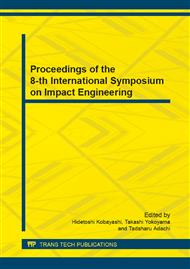p.211
p.219
p.225
p.232
p.238
p.244
p.250
p.256
p.262
High-Velocity Impact between Vehicles and Soft Bodies
Abstract:
The speed record for a ground transportation train is held by a linear motor car, whose running speed exceeds 500 km/h. The possibility of collision with animals, generally birds, is a hazard. Thus, materials that are both lightweight and high-strength have become the ideal candidates for the front cover on bullet trains. Before studying the high-velocity impact behaviors of the candidate materials, we gathered some reference data by implementing a high-velocity impact using the aluminum alloy that was used in the testing of bird impacts on airplanes, and selected the A6061-T6 plate. The soft body was fabricated using 1.25 kg of gelatin with a collision cross section of φ100 mm; the maximum collision velocity in the tests was 550 km/h, and the target plate had dimensions of 500 × 500 × 3 mm. The plate was tested with and without a fixed peripheral part, and the results of these boundary conditions were compared. Strain gauges were attached to the backside of the plate to try to acquire the distribution of the strain history. The test specimens were prepared from a plate from the same lot, and tensile tests at a static strain rate (10-5/s), a medium strain rate (0.1–20/s), and a high strain rate (100–1000/s) were conducted. The data for the constitutive laws of the numerical analysis were acquired and analyzed. The results of the experiment and the analysis of the strain history of the area neighboring the impact point were compared and discussed. A main conclusion of the experiment is that the target plate with a fixed peripheral part was not penetrated when the velocity was 550 km/h, and the residual displacement did not exceed approximately 60 mm. The strain energy on the dynamic characteristics to uniform elongation becomes effective in a decision for failure of a target material.
Info:
Periodical:
Pages:
238-243
Citation:
Online since:
June 2014
Authors:
Price:
Сopyright:
© 2014 Trans Tech Publications Ltd. All Rights Reserved
Share:
Citation:


